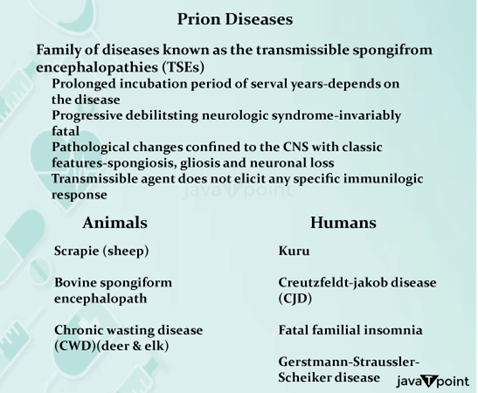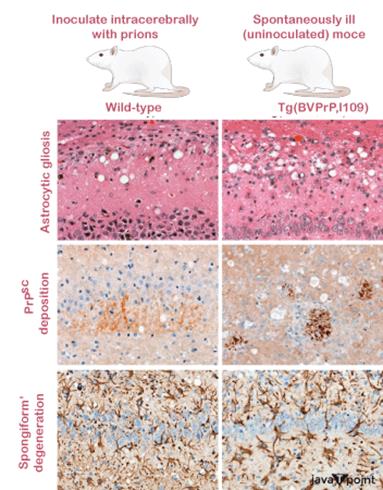Prion DiseaseA prion is a protein that has been improperly folded and may spread to other normal forms of the same protein, causing cellular death. Transmissible spongiform encephalopathies (TSEs), lethal neurodegenerative illnesses in people and animals, are prion diseases caused by prions. The proteins may intermittently misfold as a result of genetic abnormalities or exposure to a protein that is already misfolded. They now have the capacity to lead to the misfolding of other proteins due to the resulting aberrant three-dimensional shape. 
The phrase "proteinaceous infectious particle" is where the word "prion" originates. In contrast to all other known infectious agents, including viroids, viruses, bacteria, fungi, and parasites, which all include nucleic acids (DNA, RNA, or both), the involvement of a protein as an infectious agent is hypothesized. What is Prion Disease?Prion illnesses, also known as transmissible spongiform encephalopathies, are a group of uncommon progressive neurodegenerative diseases that afflict both people and animals. Long incubation times, distinctive spongiform alterations connected to neuronal death, and an inability to elicit an inflammatory response set them apart. Prions are thought to be the underlying causes of TSEs. The name "prions" refers to aberrant, pathogenic substances that are contagious and have the capacity to cause the improper folding of certain normal cellular proteins known as prion proteins, which are mostly present in the brain. There is still much to learn about how these typical prion proteins work. In addition to brain damage, the disease's recognizable signs and symptoms are caused by the prion proteins' aberrant folding. Usually deadly and quickly progressing, prion illnesses are. Proteopathy, or a disorder of structurally disordered proteins, is a category of illness that includes prion diseases. Prions are thought to be the root cause of the Creutzfeldt-Jakob disease (CJD), its variation (vCJD), Gerstmann-Sträussler-Scheinker syndrome (GSS), fatal familial insomnia (FFI), and kuru in humans. In addition, there is evidence that suggests prions may contribute to the development of prion-like disorders, including ALS, Parkinson's disease, and Alzheimer's disease. Like other yeast proteins, a protein-altering synapse during memory development also exhibits prionogenic capabilities. Similar to other kinds of replication, prion replication is vulnerable to epimutation and natural selection, and the structure of prion replication differs somewhat across species. Causes of Prion DiseasePRNP gene mutations account for 10 to 15 percent of all instances of prion disease. These prion diseases are categorized as familial because they may run in families. Familial prion illnesses, which share symptoms and signs, include fatal familial insomnia (FFI), Gerstmann-Sträussler-Scheinker syndrome (GSS), and familial Creutzfeldt-Jakob disease (CJD). 
The prion protein (PrP) is a protein that may be produced using instructions from the PRNP gene. Researchers have postulated functions for this protein in a number of critical activities despite the fact that its exact function still needs to be determined. These include the transfer of copper into cells, neuroprotection, or brain cells (neurons) ability to communicate with one another after injury. One copy of the PRNP gene produces the abnormally shaped protein PrPSc in family types of prion disease as a consequence of mutations in the PRNP gene. PrPSc may bind to the regular protein (PrPC) and encourage its conversion into PrPSc via an unidentified method. The aberrant protein amasses the brain, clumping together to harm or kill neurons. The absence of these cells results in tiny sponge-like holes (vacuoles) in the brain, which causes the prion disease symptoms. Spontaneous or acquired prion disease accounts for 85 to 90 percent of cases. No one in their family has ever had prion disease, and there is no known PRNP gene mutation in those who have sporadic prion disease. Sporadic sickness develops when PrPC transforms into PrPSc on its own for unexplained causes. Among the sporadic prion diseases are variably protease-sensitive prionopathy (VPSPr), sporadic fatal insomnia (sFI), and sporadic Creutzfeldt-Jakob disease (sCJD). PrPSc from an external source may cause acquired prion disease. For example, ingesting beef products containing PrPSc from cattle with prion disease causes variant Creutzfeldt-Jakob disease (vCJD), a human-acquired prion disease. This illness's name in cows is bovine spongiform encephalopathy (BSE), or more frequently, "mad cow disease." Kuru is another example of a human prion disease that has been acquired. It was discovered in the South Fore people of Papua New Guinea. The condition was spread when participants in cannibalistic burial ceremonies ate afflicted human flesh. Rarely, prions may spread by unintentional contact with tissues that have been exposed to PrPSc during a surgical operation. Iatrogenic is the label given to this particular kind of prion disease, which makes up 1 to 2 percent of all cases. Types of Prion DiseaseHuman Prion Disease1. CJD This disorder may be inherited, in which case it is known as familial CJD. On the other hand, sporadic CJD appears out of the blue with no established risk factors. The majority of CJD occurrences are sporadic and often affect persons in their 60s. During a medical treatment, such as a cornea transplant, exposure to contaminated tissue might result in the development of CJD. CJD symptoms (see below) may cause death and severe impairment in a short amount of time. Death often happens within a year. 2. CJD variant This illness is an infectious form connected to "mad cow disease." Humans may get the sickness through eating infected meat. The meat may contribute to the aberrant development of normal human prion protein. Younger persons are often affected by this sort of sickness. 3. Variably Protease-Sensitive Prionopathy (VPSPr) It is comparable to CJD but far more uncommon, and the protein is less susceptible to digestion. People with a family history of dementia who are approximately 70 years old are more likely to experience it. 4. Gertmann-Sträussler-Scheinker Disease (GSS) It's extremely uncommon but happens early, usually around age 40. 5. Kuru New Guinea experiences this illness. Eating human brain tissue infected with infectious prions is what causes it. Kuru is uncommon due to greater knowledge of the illness and its transmission. 6. Fatal insomnia (FI) A rare inherited condition that makes it difficult to sleep. There is also an uninherited sporadic type of the illness. Animal Prion Disease1. Bovine Spongiform Encephalopathy(BSE) This kind of prion illness, sometimes known as "mad cow disease," affects cows. Humans who eat meat from BSE-infected cows may get vCJD. 2. Chronic Wasting Disease (CWD) Animals, including deer, moose, and elk, are affected by CWD. Its name is derived from the extreme weight loss seen in ill animals. 3. Scrapie The first kind of prion illness, scrapie, was first documented in the 1700s. Sheep and goats are among the affected species. 4. Feline Spongiform Encephalopathy (FSE) Both domestic cats and wild cats are kept as FSE impacts pets. With some instances have been reported in other regions of Europe and Australia, the United Kingdom has seen the majority of FSE cases. 5.Transmissible Mink Encephalopathy (TME) Mink are afflicted by this very unusual kind of prion disease. Small mammals like minks are often farmed for their fur. Misfolded proteins in the central nervous system are linked to Parkinson's disease and Alzheimer's disease, among other neurodegenerative conditions. According to the study, some improperly folded proteins may be prions. However, other researchers contend that these proteins merely behave in a prion-like manner. They contend that because the illnesses they cause, like Alzheimer's, aren't considered to be contagious, they can't be prions. Symptoms of Prion DiseasePrion illnesses have very lengthy incubation periods, sometimes in the tens of years range. When symptoms start to appear, they can deteriorate quickly. The following are typical signs of prion disease:
How Prion Disease is Diagnosed?Prions illnesses may be challenging to identify since their symptoms might be similar to those of other neurodegenerative diseases. After death, a brain biopsy is the only means to identify prion disease definitively. However, a doctor can identify prion disease using a combination of your symptoms, medical history, and a number of tests. They could carry out tests like: 1. MRI Your brain may be visualized in great detail with an MRI. This may assist medical professionals in visualizing prion disease-related alterations to brain structure. 2. Cerebralspinal Fluid(CSF) Testing It is possible to collect CSF and examine it for signs of neurodegeneration. A test to precisely find signs of the human prion disease was developed in 2015. 3. Electroencephalography (EEG) An EEG captures your brain's electrical activity. With prion diseases, abnormal patterns might appear, especially with CJD, when brief spikes in activity may be seen. Treatment of Prion DiseaseThe prion illness is now incurable. However, supportive care is the main component of therapy. These are some instances of this style of care: 1. Medications- To address symptoms, doctors may prescribe certain drugs. Examples comprise:
2. Assistance- Many individuals need assistance with everyday tasks and self-care as the illness worsens. 3. Supplying nutrients and water- A feeding tube or intravenous fluids may be needed in cases of severe illness. Researchers are still trying to develop a cure for prion illnesses. The use of "anti-prions" that prevent the reproduction of aberrant PrP and anti-prion antibodies are a few of the possible treatments under investigation. Can Disease Be Prevented?A number of techniques have stopped the spread of acquired prion disorders. These preventative measures have made it exceedingly unlikely for someone to get a prion illness via food or in a hospital environment. Among the precautions taken are the following:
Neither the hereditary nor the spontaneous types of prion disease are presently curable. If someone in your family has a prion disease, you may think about speaking with a genetic counselor to learn more about your risk of contracting the illness. SummaryAn uncommon class of neurodegenerative illnesses known as prion diseases is brought on by improperly folded proteins in your brain. The misfolded protein aggregates into clumps that harm nerve cells, gradually impairing brain function. While some prion illnesses are acquired by contaminated food or medical devices, others may be contracted through hereditary transmission. Other prion disorders manifest with no apparent reason. Prion illnesses are presently incurable. Instead, the emphasis of therapy is on symptom relief and supportive care. Researchers are still working to learn more about these disorders and identify viable remedies.
Next TopicMyasthenia Gravis
|
 For Videos Join Our Youtube Channel: Join Now
For Videos Join Our Youtube Channel: Join Now
Feedback
- Send your Feedback to [email protected]
Help Others, Please Share









